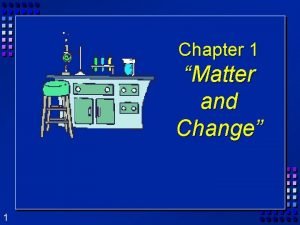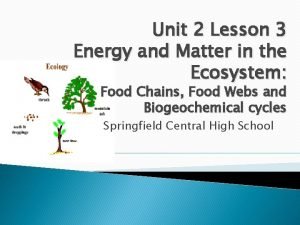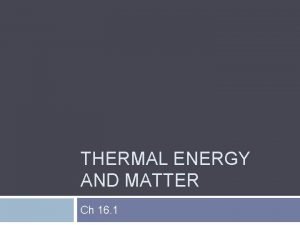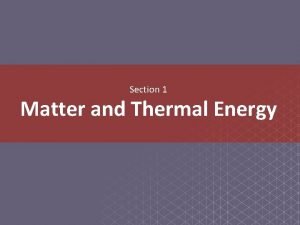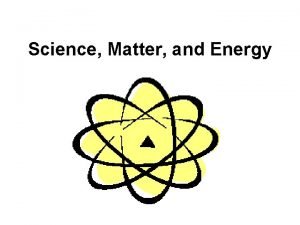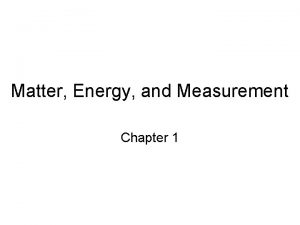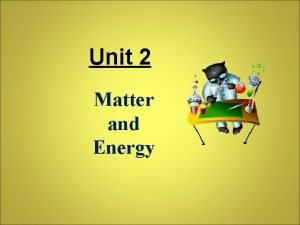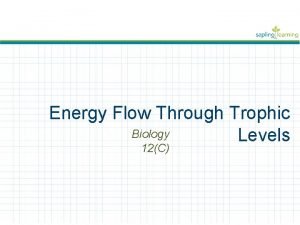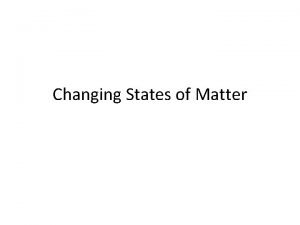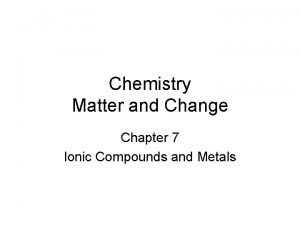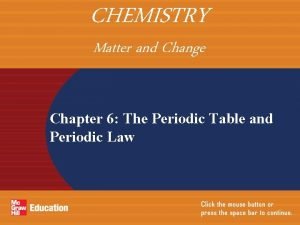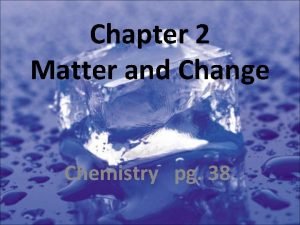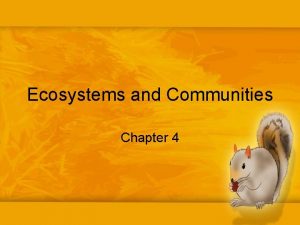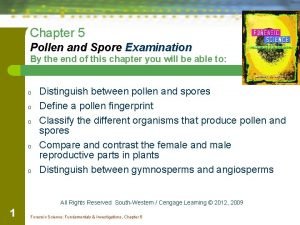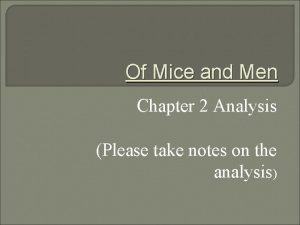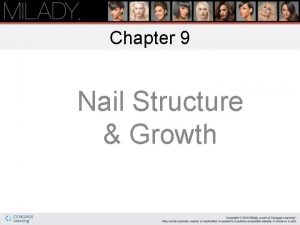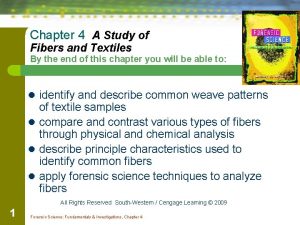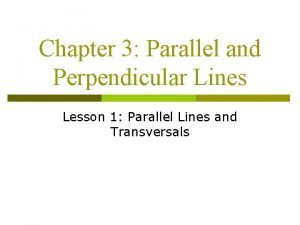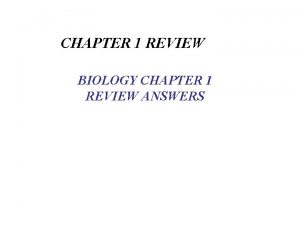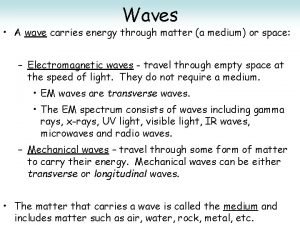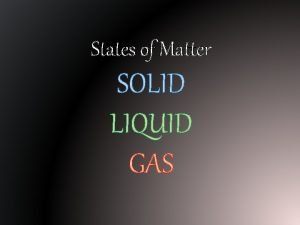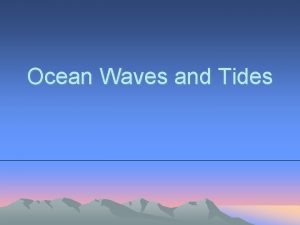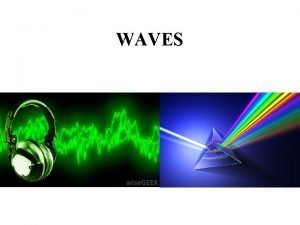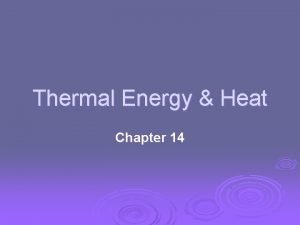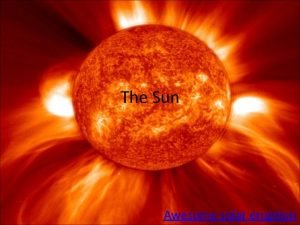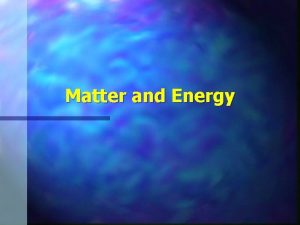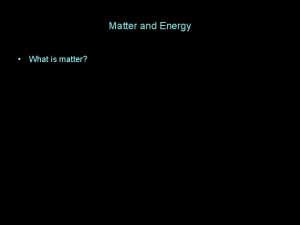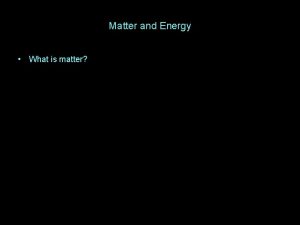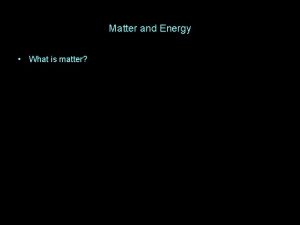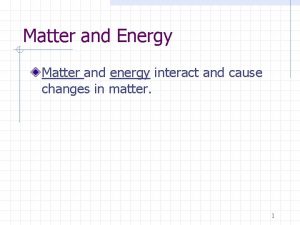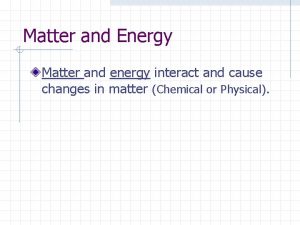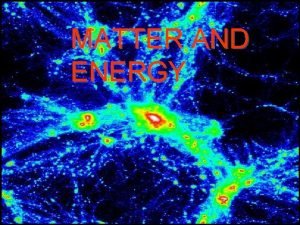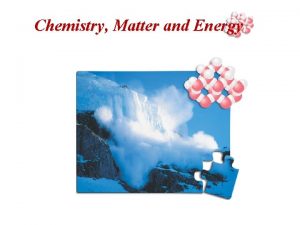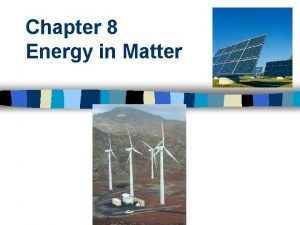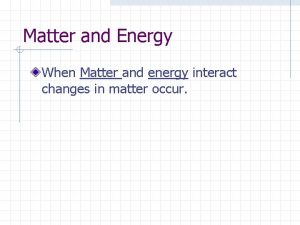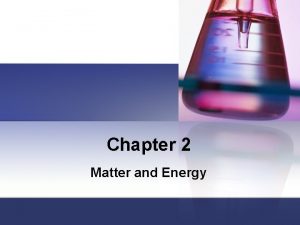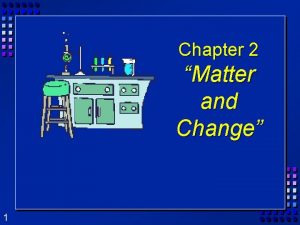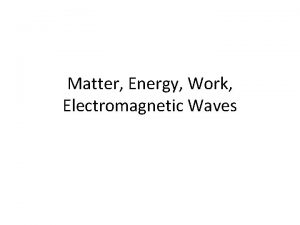Matter and Energy Review Chapter 3 Matter Energy


















































































- Slides: 82

Matter and Energy Review Chapter 3 Matter Energy and Systems Chapter 4 Biogeochemical cycles Go to quiz

Natural Capital: Sustaining Life of Earth Ø One-way flow of energy from Sun Ø Cycling of Crucial Elements Fig. 4 -8 p. 60

Solar Capital: Flow of Energy to and from the Earth Fig. 4 -9 p. 61

The Law of Conservation of Matter Ø Matter is not destroyed Ø Matter only changes form Ø There is no “throw away”

Laws Governing Energy Changes First Law of Thermodynamics (Energy) Ø Energy is neither created nor destroyed Ø Energy only changes form Ø You can’t get something for nothing ENERGY IN = ENERGY OUT

Laws Governing Energy Changes Second Law of Thermodynamics entropy Ø In every transformation, some energy is converted to heat Ø You cannot break even in terms of energy quality

Energy: Quality Ø High-quality energy Ø Low-quality energy Fig. 3 -12 p. 46

Connections: Matter Cycling in Ecosystems Ø Biogeochemical cycles Ø Hydrologic cycle (H 2 O) Ø Carbon cycle Ø Nitrogen cycle Ø Phosphorus cycle Ø Sulfur cycle

Hydrologic (Water) Cycle Fig. 4 -28 p. 76

The Carbon Cycle (Marine) Fig. 4 -29, p. 78

The Carbon Cycle (Terrestrial) Fig. 4 -29, p. 78

The Nitrogen Cycle Fig. 4 -31 p. 80

The Phosphorus Cycle Fig. 4 -33 p. 82

The Sulfur Cycle Fig. 4 -34 p. 83

Case Study • Hubbard Brook Experimental Forest. Study centered on how deforestation affects nutrient cycles. The forest consisted of several watersheds each drained by a single creek. Impervious bedrock was close to the surface, which prevented seepage of water from one forested hillside, valley, and creek ecosystem to another.

• Conclusions: An undisturbed mature forest ecosystem is in dynamic equilibrium with respect to chemical nutrients. Nutrients leaving ecosystem are balanced by nutrients entering the ecosystem. Inflow and outflow of nutrients was low compared to levels of nutrients being recycled within the ecosystem.

When deforestation occurred, water runoff increased. Consequently, soil erosion increased which caused a large increase in outflow of nutrients from the ecosystem. Increase in outflow of nutrients causes water pollution. Nutrient loss could be reduced by clearing trees and vegetation in horizontal strips. Remaining vegetation reduced soil erosion.

Matter and Energy Review Quiz

1. The Hubbard Brook experiment demonstrated that (A) nutrient loss could be increased by clearing trees and vegetation in horizontal strips. The remaining vegetation reduced soil erosion. (B) inflow and outflow of nutrients was high compared to levels of nutrients being recycled within the ecosystem. (C) when deforestation occurred, water runoff increased. Consequently, soil ero sion decreased, which caused large increase in outflow of nutrients from the ecosystem. (D) an undisturbed mature forest ecosystem is in dynamic equilibrium with respect to chemical nutrients. Nutrients leaving the ecosystem are balanced by nutrients entering ecosystem. (E) all of the above

(D) In choice A, horizontal strips would help to prevent nutrient loss through erosion. In choice B, inflow and outflow of nutrients was stable when compared to the level of nutrients being recycled. In choice C, soil erosion would increase due to deforesta tion. Choice D is valid only in an undisturbed forest ecosystem, which is the premise of the choice. The Hubbard Brook Experimental Forest in New Hampshire, the longest running forest ecosystem experiment in North America, did show that in a disturbed forest ecosystem, one that had an input of acid rain, forest soils became depleted of natural buffering cations such as Ca 2+ and Mg 2+ over the years. Those cations were replaced by hydrogen and aluminum cations, which resulted in tree loss.

2. Which of the following sinks is NOT a primary depository for the element listed? (A) Carbon—coal (B) Nitrogen—nitrogen gas in the atmosphere (C) Phosphorus—marble and limestone (D) Sulfur—deep ocean deposits (E) All are correct

(C) The primary sink for phosphorus is ocean sediment and certain islands off South America and the Pacific island nation of Nauru that have or had high amounts of bird guano.

3. Burning of fossil fuels coupled with deforestation increases the amount of. in the atmosphere. (A) N 02 (B) C 02 (C) S 02 (D) 03 (E) all of the above are correct

(B) Burning of fossil fuels releases sulfur oxides (SOx), carbon oxides (COx. —carbon dioxide on complete combustion, carbon monoxide on incomplete combustion), and nitrogen oxides (NOX). Ozone is a photochemical oxidant that is produced in a sec ondary atmospheric reaction involving the formation of atomic oxygen through split ting nitrogen dioxide (NO 2) and is not produced directly by burning fossil fuels. Deforestation, or the removal and burning of trees and other vegetation on a large scale (slash and burn) to expand agricultural or grazing lands, releases primarily car bon dioxide. Since the question said "coupled, " the gas that is common to both processes is carbon dioxide.

4. In the nitrogen fixation cycle, cyanobacteria in soil and water and Rhizobium bacteria in root systems of legumes are responsible for converting (A) organic material to NH 3 and NH 4+. (B) NH 3, NH 4+, and NO 3 to DNA, amino acids, and proteins. (C) NH 3 and NO 2 to NO 3 (D) N 2 and H 2 to NH 3. (E) NH 3 to NO 2 and then to NO 3

(D) This is the first step in the nitrogen cycle and is called nitrogen fixation. Refer to Step 1 in the nitrogen cycle for details on nitrogen fixation.

5. An industrial method used to manufacture nitrogen rich fertilizer is known as (A) nitrogen fixation process (B) Haber process (C) ammonium conversion (D) cracking (E) nitrogen enrichment

(B) The industrial production of ammonia through the Haber process is the same chemical reaction as nitrogen fixation: N 2 + 3 H 2 » 2 NH 3. The differences between the bacterial process and a process that occurs in factories are the pressures and temperatures required in the industrial manufacturing. The production of ammonia through the Haber process ranks as one of the most produced chemicals in the world, the reason being the world's need for fertilizer.

6. Nitrogen is assimilated in plants in what form? (A)N 02 (B)NH 3 (C) NH 4+ (D) N 03 (E) Choices B, C, and D

(E) The nitrite ion (NO 2 ) is toxic to plants. In the nitrogen cycle, at a step called assimilation, plant roots can absorb ammonia (NH 3), ammonium ion (NH 4+) and nitrate ion (NO 3 ).

7. Plants primarily assimilate sulfur in what form? (A) Sulfates (B) Sulfites (C) Hydrogen sulfide (D) Sulfur dioxide (E) Elemental sulfur

(A) Hydrogen sulfide (H 2 S) and sulfur dioxide (SO 2) are toxic to living organisms. Most of the sulfur in the world is stored either in the elemental form and is extracted using hot steam through a method called the Frasch process or as sulfate compounds. Some sulfate compounds are water soluble, allowing the sulfate anion (SO 42 ) to be absorbed by the plant. Free sulfur is not soluble in water and is not able to be absorbed. Plants cannot effectively absorb sulfite ions (SO 32 ).

8. Man increases sulfur into the atmosphere and thereby increases acid deposition by all of the following activities EXCEPT (A) industrial processing. (B) processing (smelting) ores to produce metals. (C) burning coal. (D) petroleum refining. (E) clear cutting.

(E) Clear cutting produces carbon dioxide (CO 2), not SOx.

9. Phosphorus is being added to the environment by all of the following activities EXCEPT (A) runoff from feedlots. (B) clear cutting in tropical areas. (C) stream runoff. (D) burning coal and petroleum. (E) mining to produce inorganic fertilizer.

(D) Animal manure and bird guano are rich in phosphate. In the tropics, most of the nutrients are contained within the trees and vegetation, with little being retained in the soil. Phosphorus therefore would be released back into the environment by clear cut ting. It would then be subject to runoff. Mining phosphates for fertilizer and industri al products takes phosphorus out of sinks and puts it into the environment for cycling. Burning coal and petroleum does not add appreciable phosphorus to the environment.

10. Carbon dioxide is a reactant in (A) photosynthesis. (B) cellular respiration. (C) Haber process. (D) nitrogen fixation. (E) none of the above.

(A) Photosynthesis is written as 6 CO 2 (g) + 12 H 2 O (1) + Light Energy => C 6 H 12 O 6 (aq) + 6 CO 2 (g) + 6 H 20 Cellular respiration is the reverse reaction. C 6 H 12 O 6 (aq) + 6 O 2 (g) + 6 H 2 O » 6 CO 2 + 12 H 2 O (1) + ATP Energy

11. Human activity adds significant amounts of carbon dioxide to the atmosphere by all of the following EXCEPT (A) brush clearing. (B) burning wood. (C) burning petroleum. (D) clear cutting. (E) agricultural runoff.

(E) Agricultural runoff, primarily from fertilizers and feedlots, adds nitrates and phosphates to streams. All other choices involve combustion, which produces car bon dioxide.

12. Clearing of land for either habitation or agriculture does all of the following EXCEPT (A) increases runoff. (B) increases flood risks. (C) increases potential for landslides. (D) increases infiltration. (E) accelerates soil erosion.

(D) Infiltration is the movement of water into the soil. Removing vegetation decreas es infiltration by not allowing water to percolate slowly through the soil. Removing vegetation will increase runoff since water cannot be absorbed by the soil fast enough. Since runoff is increased, the potential for floods increase. Since floods and runoff increase, the soil can become saturated and lose its integrity and result in a landslide. Runoff carries with it topsoil and nutrients thus accelerating soil erosion.

13. All the following have an impact on the nitrogen cycle EXCEPT (A) the application of inorganic fertilizers applied to the soil. (B) the action of aerobic bacteria acting on livestock wastes. (C) the overplanting of nitrogen rich crops. (D) the discharge of municipal sewage. (E) the burning of most fuels.

(B) The bacteria that "digest" livestock wastes are anaerobes and operate only in anaerobic environments (no free oxygen). They produce nitrous oxide (N 2 O). Other bacteria can be used to generate methane gas from animal manure in what is known as a "digester. " In this process, anaerobic digestion is a two part process and each part is performed by a specific group of organisms. The first part is the breakdown of complex organic matter (manure) into simple organic compounds by acid form ing

bacteria. The second group of microorganisms, the methane formers, break down the acids into methane and carbon dioxide. This methane gas can then be used for heating. Inorganic fertilizers lose up to 80% of their nitrogen to the atmosphere through denitrification caused by bacterial action. Municipal sewage and nitrogen rich crops release nitrogen into the environment. Burning most fuels assumes that fossil fuels, which produce (NOx), are included.

14. A macronutrient essential to the formation of proteins.

15. A micronutrient that is a component of several enzymes and involved in enzymatic reduction of nitrates to ammonia. It assists in conversion of inorganic phosphate to organic form. In plants, it improves nodule formation and fixation of nitrogen. It assists protein formation and is required for the synthesis and activity of the enzyme nitrate reductase (reduces nitrates to ammonium in the plant. )

MACRONUTRIENTS (MAKE UP MORE THAN 0. 2% OF DRY WEIGHT) Role Nutrient Calcium Principal skeletal mineral in bones and teeth, muscle contraction and relaxation, nerve function, intracellular regulation, extracellular enzyme cofactor, blood clotting, and blood pressure. Involved in for mation of cell walls. Participates in translocation of sugars. In plants, it improves fruit and nut formation. Root and leaf development. Involved in uptake of other nutrients. Improves postharvest quality of fruits and vegetables. Aids in the control of certain fungal and bacterial diseases. Carbon Forms carbohydrates with oxygen and hydrogen. Carbon is a major com ponent of organic molecules, which are the building blocks of all organisms. Hydrogen is a major component of organic molecules, which are the building blocks of all organisms. Nitrogen Involved in making proteins. Oxygen is a major component of organic molecules, which are the building blocks of all organisms. Phosphorus Acid base balance, DNA/RNA structure, energy, and enzyme cofactor. Found in every cell. Potassium Protein synthesis, fluid balance, muscle contraction, and nerve transmission. Sodium Acid base balance and fluid retention. Involved in nerve impulse trans mission. Sulfur Component of biotin, thiamin, insulin, and some amino acids. Involved in formation of nodules and chlorophyll synthesis; a structural compo nent of amino acids and enzymes. In plants, it improves cold resistance and disease resistance. Assists decomposition of crop residue. Involved hi protein formation and uptake of other nutrients.

MICRONUTRIENTS OR TRACE ELEMENTS (MAKE UP LESS THAN 0. 2% OF DRY WEIGHT) Nutrient Role Aluminum A micronutrient required for proper development and growth in plants. Requirements in human nutrition have not been established. Boron Involved in formation of cell walls, terminal buds, and pollen tubes, Participates in regulation of starch production and translocation of sugars and starches. In plants, it improves quality and disease resistance. Involved in seed, flower, and fruit formation. Chlorine Fluid balance, aids digestion in stomach. Chromium Energy release, sugar and fat metabolism, potentiates the action of insulin. Cobalt As a component of vitamin B 12, aids in nerve function and blood formation. Copper Absorption of iron, part of many enzymes. Involved in photosynthetic and respiration systems. Assists chlorophyll synthesis and used as reaction catalyst. In plants, it improves nitrogen utilization. Involved in protein formation and root metabolism Fluorine Bone and teeth formation; decreases dental caries. Iodine Component of the hormone thyroxin, which aids in metabolism reg ulation and fetal development. Iron Hemoglobin formation in red blood cells, myoglobin formation in muscle, oxygen carrier, energy utilization. Involved in respiration and chlorophyll synthesis. In plants, it improves plant appearance. Required for vigorous growth.

Magnesium Bone mineralization, protein synthesis, enzymatic reactions, muscu lar contraction, nerve transmission. Involved in photosynthetic and respiration system. Active in uptake of phosphate and translocation of phosphate and starches. In plants, it improves seed production and formation of seed oil and fat. Involved in uptake of other nutrients. Manganese Involved in regulation of enzymes and growth hormones. Assists in photosynthesis and respiration. In plants, it improves germination and hastens maturity. Involved in uptake of carbon, magnesium, and phosphorous. Manganese is important in resistance development to both root and foliar diseases caused by fungi. Molybdenum Component of a several enzymes and involved in enzymatic reduction of nitrates to ammonia. Assists in conversion of inorganic phos phate to organic form. In plants, it improves nodule formation and fixation of nitrogen. Assists protein formation. Required for the syn thesis and activity of the enzyme nitrate reductase (reduces nitrates to ammonium in the plant). Selenium Protects against oxidation. MICRONUTRIENTS OR TRACE ELEMENTS (MAKE UP LESS THAN 0. 2% OF DRY WEIGHT) (continued) Role Nutrient Silicon Promotes the synthesis of collagen and formation of bone. Vanadium Involved in enzyme activities in the body. Zinc Transport of vitamin A, taste, wound healing, sperm production, fetal development. Plays a part in many enzymes, hormones (insulin), genetic material, and proteins. Involved in production of growth hormones and chlorophyll. Active in respiration and carbo hydrate synthesis. In plants, it improves plant appearance, seed pro duction and absorption of water. Involved in protein and carbohy drate formation.

Energy Multiple-Choice Questions

16. Which of the following forms of energy is a renewable resource? (A) Synthetic oil (B) Breeder fission (C) Biomass (D) Oil shale (E) Synthetic natural gas

(C) Renewable resources are those resources that theoretically will last indefinitely either because they are replaced naturally at a higher rate than they are consumed or because their source is essentially inexhaustible. Biomass can either be the burning of wood and agricultural wastes or urban wastes that can be incinerated.

17. Which of the following forms of energy has a low long term (next 50 years) estimated availability? (A) Low temperature heating from solar energy (B) Synthetic oil and alcohols from coal (C) Photovoltaic production of electricity (D) Coal (E) Petroleum

(E) At the current rate of consumption, global oil reserves are only expected to last another 45 to 50 years. With projections of increased consumption in the near future, this figure will be even lower.

18. Which of the following forms of energy is characteristic of having high net useful energy? (A) Tar sands (B) Wind energy (C) Fission (D) Synthetic natural gas (E) Geothermal energy

(B) Net useful energy is defined as the total amount of useful energy available from an energy resource over its lifetime minus the amount of energy used (first law of thermodynamics), wasted (second law of thermodynamics), and used in processing and transporting it to the end user. Wind energy is essentially an unlimited resource in favor able sites.

19. Which of the following alternatives would not lead to a sustainable energy future? (A) Phase out nuclear power subsidies. (B) Create policies to encourage governments to purchase renewable energy devices. (C) Assess penalties or taxes on continued use of coal and oil. (D) Decrease fuel efficiency standards for cars, appliances, and HVAC systems. (E) Create tax incentives for independent power producers.

(D) The key word in the question is "not. " To foster a sustainable energy future, one would have to increase fuel efficiency standards for cars, appliances, and HVAC (heat ing, ventilation and air conditioning) systems.

20. At today's rate of consumption, known U. S. oil reserves will be depleted (A) in approximately 100 years. (B) in approximately 50 years. (C) in approximately 25 years. (D) in approximately 10 years. (E) in approximately 3 years.

(C) World oil demand is increasing at a rate of about 2% per year. Known U. S. oil reserves are projected to last about another 25 years. Potential reserves (Alaskan Arctic National Wildlife Refuge for example) might extend the estimate another 25 years.

21. Which country currently ranks number one in both coal reserves and use of coal as an energy source? (A) Russia (B) United States (C) China (D) India (E) Brazil

(C) China gets approximately 75% of its energy from coal. Coal supplies over half of the fuel source to generate electricity in the United States. Utilities are the largest users of coal in the United States.

22. The lowest average generating cost (cents per kilowatt hour) comes from what energy source? (A) Large hydroelectric facilities (B) Geothermal (C) Nuclear (D) Solar photovoltaics (E) Coal

(A) Nonrenewable resources of energy (natural gas, oil, etc. ) have had recent and dramatic price increases which have resulted in major increases in the cost of electricity. In the United States, this began in 2001 in California. Renewable resources of energy (hydroelectric and wind) provide the least expensive energy source for producing electricity. With increases in technology and production, wind energy is expected to be competitive in price with energy supplied by hydroelectric power plants.

23. The fastest growing renewable energy resource today is (A) nuclear energy. (B) coal. (C) wind. (D) large scale hydroelectric plants. (E) geothermal energy.

(C) During the 1990 s, wind power experienced a growth of 22% per year. Wind power supplies less than 2% of the energy used in the United States, primarily because it is a new industry. The country that is the largest user of wind power is Denmark, with 8% of its electricity being generated by the wind. Germany, Spain, and India are also large wind power users. China has enough potential wind power sites (especially in Inner Mongolia) to provide all that country's electricity needs.

24. The least efficient energy conversion device listed is the (A) steam turbine (B) fuel cell (C) fluorescent light (D) incandescent light (E) internal combustion engine

(D) An incandescent light bulb is only 5% efficient, as compared to a fluorescent light at around 22% efficiency. A hydrogen fuel cell is approximately 60% efficient. The average current internal combustion engine, fueled by gasoline, is around 10% efficient. The United States wastes as much energy each day as two thirds of the world consumes.

25. Which is NOT an advantage of using nuclear fusion? (A) Abundant fuel supply (B) No generation of weapons grade material (C) No air pollution (D) No high level nuclear waste or generation of weapons material (E) All are advantages.

(E) The major fuel used in fusion reactors, deuterium, could be readily extracted from ordinary water, which is available to all nations. The surface waters of the Earth contain more than 10 million tons of deuterium, an essentially inexhaustible supply. The tritium required would be produced from lithium, which is available from land deposits or from seawater that contains thousands of years' supply. The worldwide avail ability of these materials would thus eliminate many current international tensions

caused by an imbalance in fuel supply. The amounts of deuterium and tritium in the fusion reaction zone would be so small that a large uncontrolled release of energy would be impossible. In the event of a malfunction, the plasma would strike the walls of its con tainment vessel and cool. Since no fossil fuels are used, there would be no release of chemical combustion products because they would not be produced. Similarly, there would be no fission products formed to present a handling and disposal problem. Radioactivity would be produced by neutrons interacting with the reactor structure, but careful materials selection would be expected to minimize the handling and ultimate disposal of activated materials. And finally, the materials and by products of fusion are not suitable for use in the production of nuclear weapons.

26. Given the following choices, which one has the greatest ability to perform useful work (high quality energy)? (A) Coal (B) Oil (C) Solar (D) Wind (E) Electricity

(E) High quality energy is defined as energy that is intense, concentrated and capa ble of performing useful work. Low quality energy is diffused, dispersed, and low in temperature. Coal and oil have waste products, which means they are not totally concentrated. Solar and wind are diffuse, and the energy produced from them at this time is relatively low power. Electricity is pure, concentrated energy.

27. Only about 10% of the potential energy of gasoline is used in powering an automobile. The remaining energy is lost into space as low quality heat. This is an example of the (A) First Law of Thermodynamics. (B) Second Law of Thermodynamics. (C) Law of Conservation of Energy. (D) first law efficiency. (E) second law efficiency.

(B) The Second Law of Energy or Thermodynamics states that when energy is changed from one form to another, some of the useful energy is always degraded to lower quality, more dispersed (higher entropy), and less useful form of energy.

28. The Law of Conservation of Mass and Energy states that matter can neither be created nor destroyed and that the total energy of an isolated system is constant despite internal changes. Which society offers the best long term solution to the constraints of this law? (A) Low throughput society (B) High throughput society (C) Matter recycling society (D) Free market society (E) Global market society

(A) A low throughput society also known as a low waste society or Earth Wisdom society focuses on matter and energy efficiency. The society accomplishes this by • Reusing and recycling nonrenewable matter resources, • Using potentially renewable resources no faster than they are replenished, • Using matter and energy resources efficiently, • Reducing unnecessary consumption, • Emphasizing pollution prevention and waste reduction, • Controlling population growth.

29. Which of the following methods CANNOT be used to produce hydrogen gas? (A) Reforming (B) Thermolysis (C) Producing it from plants (D) Coal gasification (E) All are methods of producing hydrogen gas

(E) Reforming is a chemical process of splitting water molecules. Thermolysis uses extremely high temperatures to break water molecules apart. Hydrogen gas can be pro duced from algae by depriving the algae of oxygen and sulfur. Coal gasification is the conversion of coal into synthetic natural gas (SNG). The SNG can then be converted into hydrogen gas.

30. Energy derived from fossil fuels supplies what percent of the world's energy needs? (A) 10% (B) 33% (C) 50% (D) 85% (E) 97%

(D) Oil supplies approximately 36%, coal around 26%, and natural gas around 23%. The remaining 15% of the world's energy comes from (a) nuclear, solar, wind and hydropower at a total of around 9%; and (b) wood, peat, charcoal, and biomass at around a total of 6%.
 Chapter 1 review matter and change
Chapter 1 review matter and change Flow energy review
Flow energy review Chapter 2 matter section 1 classifying matter answer key
Chapter 2 matter section 1 classifying matter answer key Chapter 10 review states of matter section 4
Chapter 10 review states of matter section 4 Chapter review motion part a vocabulary review answer key
Chapter review motion part a vocabulary review answer key Whats gray matter
Whats gray matter Dural septa
Dural septa Gray matter and white matter
Gray matter and white matter Matter
Matter Energy energy transfer and general energy analysis
Energy energy transfer and general energy analysis Energy energy transfer and general energy analysis
Energy energy transfer and general energy analysis Section 1 composition of matter
Section 1 composition of matter Section 1 composition of matter
Section 1 composition of matter Section 1 composition of matter chapter 15 answer key
Section 1 composition of matter chapter 15 answer key Classification of matter part a vocabulary review
Classification of matter part a vocabulary review Chapter 6 career readiness review
Chapter 6 career readiness review Ap gov review final exam review
Ap gov review final exam review Narrative review vs systematic review
Narrative review vs systematic review Example of inclusion and exclusion criteria
Example of inclusion and exclusion criteria Narrative review vs systematic review
Narrative review vs systematic review Phosphorus cycle
Phosphorus cycle Section 16.1 thermal energy and matter
Section 16.1 thermal energy and matter Section 1 matter and thermal energy
Section 1 matter and thermal energy Science matter and energy
Science matter and energy Matter energy and measurement
Matter energy and measurement Dark matter and dark energy ppt
Dark matter and dark energy ppt Unit 2 matter and energy
Unit 2 matter and energy Trophic level in an ecosystem
Trophic level in an ecosystem Lesson outline lesson 1 solids liquids and gases answer key
Lesson outline lesson 1 solids liquids and gases answer key Concept map for states of matter
Concept map for states of matter States of matter foldable
States of matter foldable Mechanical waves and electromagnetic waves similarities
Mechanical waves and electromagnetic waves similarities How do matter and energy interact when waves are generated
How do matter and energy interact when waves are generated Kinetic energy pyramid
Kinetic energy pyramid Chapter 7 energy conservation of energy
Chapter 7 energy conservation of energy Chemistry matter and change chapter 7
Chemistry matter and change chapter 7 Chapter 10 chemistry study guide
Chapter 10 chemistry study guide A matter of trust book summary
A matter of trust book summary Chemistry matter and change chapter 7
Chemistry matter and change chapter 7 Chemistry matter and change chapter 6
Chemistry matter and change chapter 6 Chemistry matter and change chapter 10
Chemistry matter and change chapter 10 Chemistry matter and change chapter 2 answer key
Chemistry matter and change chapter 2 answer key Circle the solute and underline the solvent
Circle the solute and underline the solvent Chapter 11 - states of matter: liquids and solids
Chapter 11 - states of matter: liquids and solids Modern chemistry chapter 14 review answers
Modern chemistry chapter 14 review answers Chapter 12 test geometry
Chapter 12 test geometry Chapter 4 ecosystems and communities
Chapter 4 ecosystems and communities Chapter 8 review chemical equations and reactions
Chapter 8 review chemical equations and reactions Chapter 8 skin disorders and diseases review questions
Chapter 8 skin disorders and diseases review questions Balancing equations chapter 8
Balancing equations chapter 8 Empirical formula and molecular formula pogil
Empirical formula and molecular formula pogil Chapter 5 pollen and spore examination review answers
Chapter 5 pollen and spore examination review answers Cash control and banking activities
Cash control and banking activities Chapter 14 weathering and erosion review answers
Chapter 14 weathering and erosion review answers Why is curley's wife nameless
Why is curley's wife nameless Love formula
Love formula Why do managers need to familiarize the nail structure
Why do managers need to familiarize the nail structure Chapter 4 fibers and textiles
Chapter 4 fibers and textiles Nail tip application procedure
Nail tip application procedure Plicatured nail treatment
Plicatured nail treatment Chapter 10 review and assessment answers
Chapter 10 review and assessment answers Chapter 10 infancy and childhood review worksheet answers
Chapter 10 infancy and childhood review worksheet answers Geometry unit 3 parallel and perpendicular lines
Geometry unit 3 parallel and perpendicular lines Broken arrow welding symbol
Broken arrow welding symbol Chapter 5 section 1 guided reading
Chapter 5 section 1 guided reading Chapter 3 review parallel and perpendicular lines
Chapter 3 review parallel and perpendicular lines Preparing textured hair for braiding
Preparing textured hair for braiding Biology chapter 1 assessment answers
Biology chapter 1 assessment answers Chapter 7 cell structure and function section review 7-2
Chapter 7 cell structure and function section review 7-2 Chapter 11 gender age and health review worksheet answers
Chapter 11 gender age and health review worksheet answers Timid bigot example
Timid bigot example Chapter 10 racial and ethnic relations review worksheet
Chapter 10 racial and ethnic relations review worksheet Chapter 10 infancy and childhood
Chapter 10 infancy and childhood Type of wave
Type of wave Waves transfer energy without transferring
Waves transfer energy without transferring Which state of matter has the most thermal energy
Which state of matter has the most thermal energy Describe the rhythmic movement of a wave
Describe the rhythmic movement of a wave Oikos meaning
Oikos meaning Waves are repeating disturbances that transfer
Waves are repeating disturbances that transfer Heat vs thermal energy vs temperature
Heat vs thermal energy vs temperature Thermal energy in states of matter
Thermal energy in states of matter Internal energy of matter
Internal energy of matter A loop of relatively cool incandescent gas
A loop of relatively cool incandescent gas
